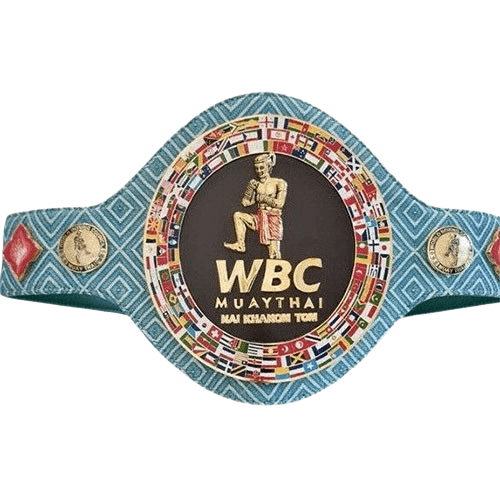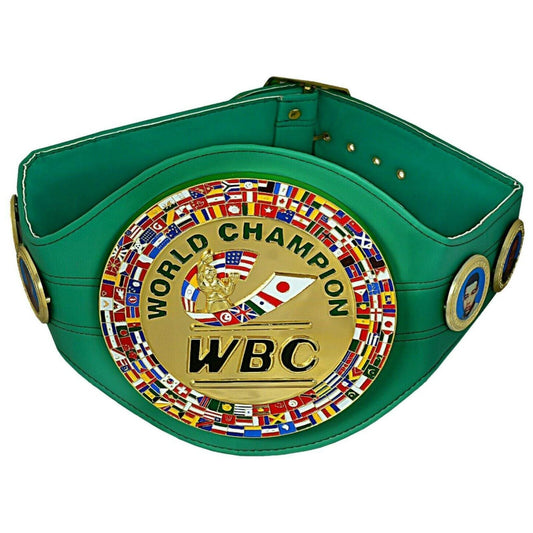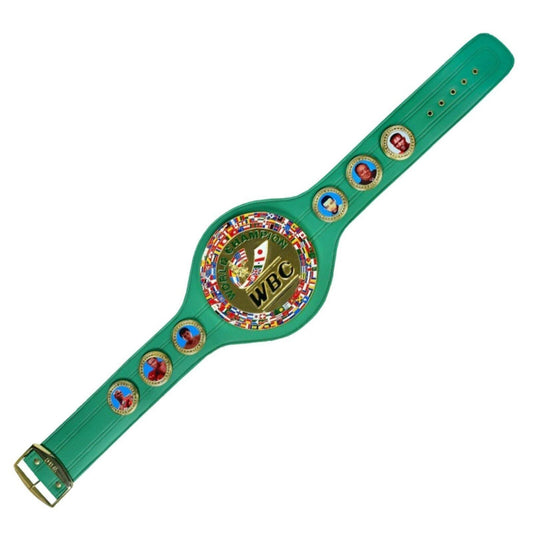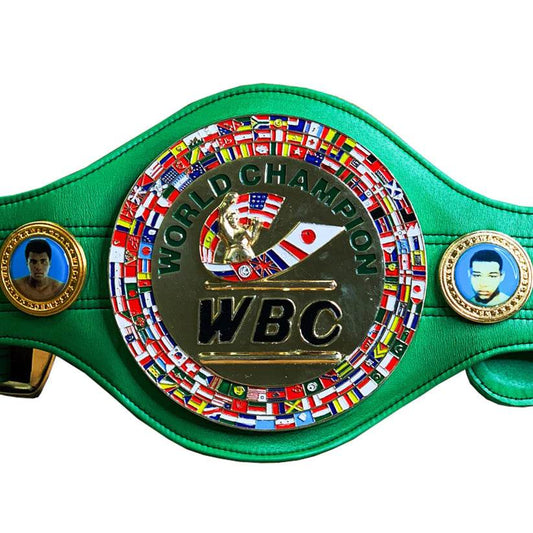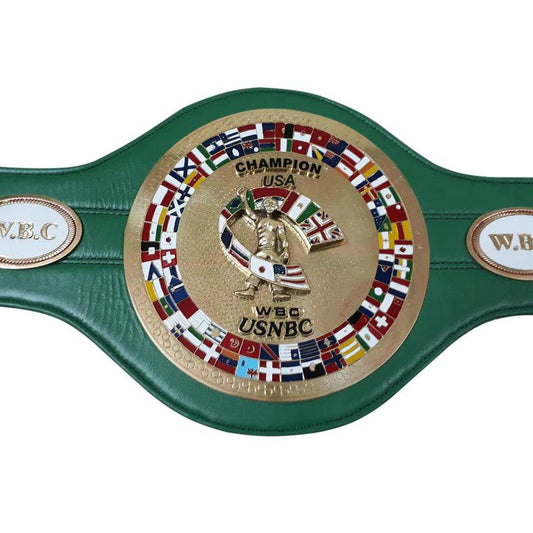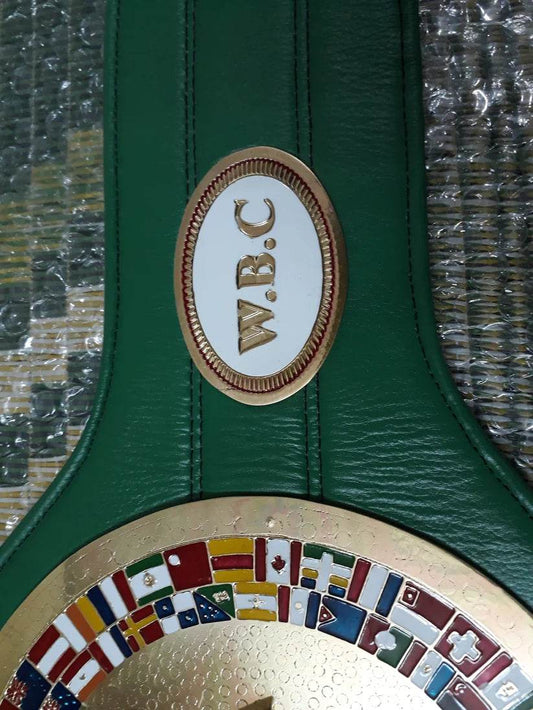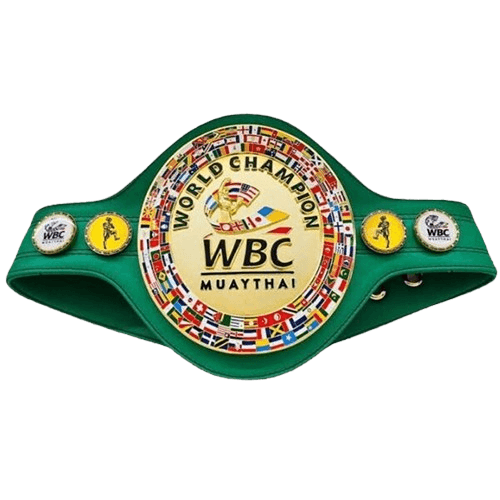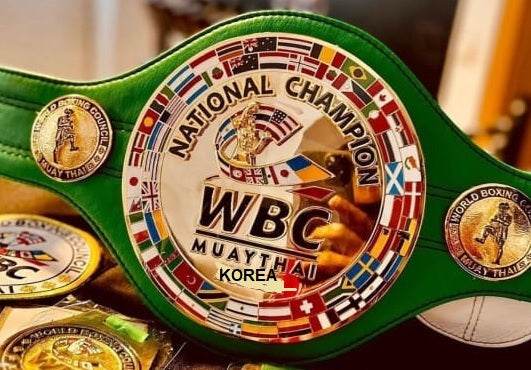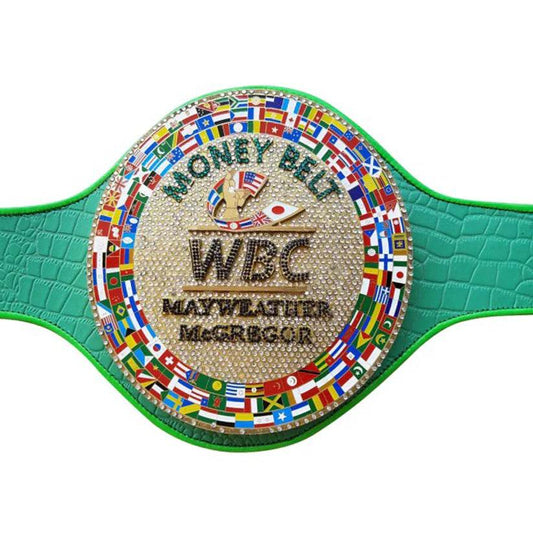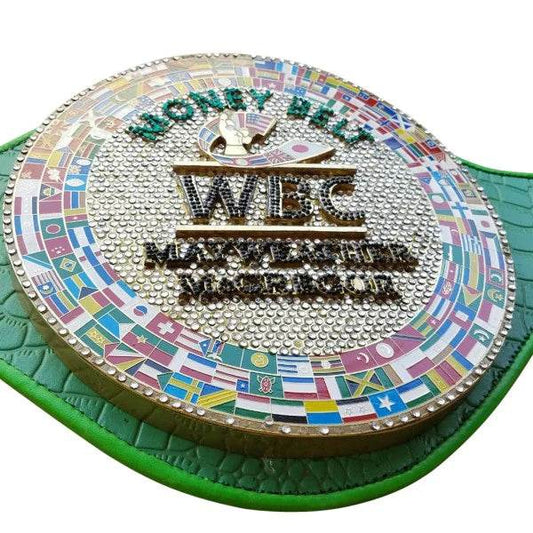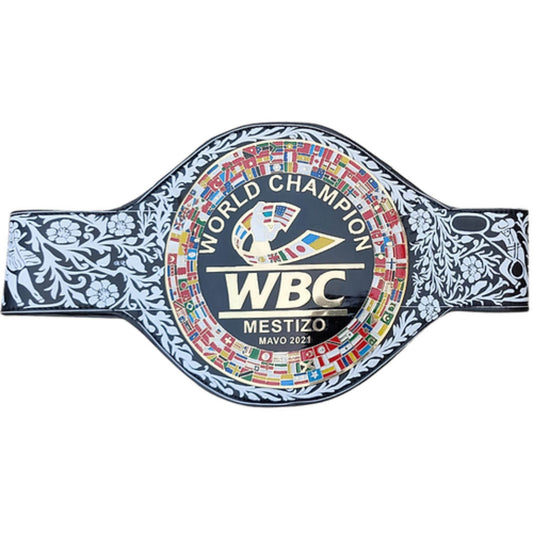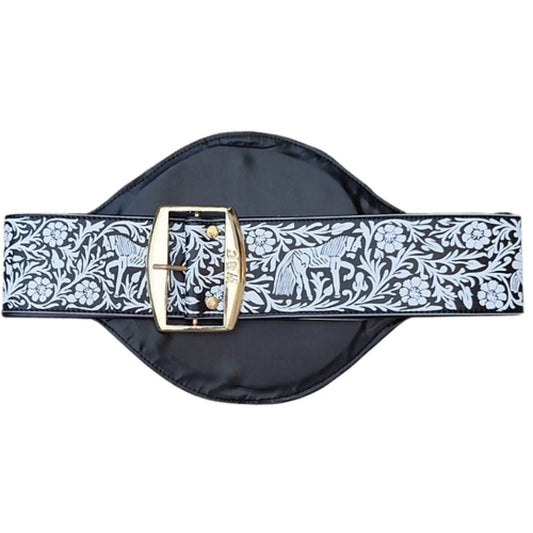-
WBC Muay thai World Boxing Champion Belt
4.5 / 5.0
(2) 2 total reviews
Regular price $179.00 USDRegular priceUnit price / per$250.00 USDSale price $179.00 USDSale -
WBC Muay Thai Nai Khanom Tom Champion Belt
4.5 / 5.0
(2) 2 total reviews
Regular price $179.00 USDRegular priceUnit price / per$250.00 USDSale price $179.00 USDSale -
WBC World Boxing Council Championship Replica Belt Adult size
4.5 / 5.0
(2) 2 total reviews
Regular price $179.00 USDRegular priceUnit price / per$200.00 USDSale price $179.00 USDSale -
WBC World Boxing Championship Title Belt
Regular price $179.00 USDRegular priceUnit price / per$250.00 USDSale price $179.00 USDSale -
Wbc Usnbc Boxing Championship Title Belt
Regular price $179.00 USDRegular priceUnit price / per$250.00 USDSale price $179.00 USDSale -
WBC MuayThai European Champion Belt
4.5 / 5.0
(2) 2 total reviews
Regular price $179.00 USDRegular priceUnit price / per$250.00 USDSale price $179.00 USDSale -
WBC Muay thai World Boxing Council Korea Champion Belt
4.5 / 5.0
(2) 2 total reviews
Regular price $179.00 USDRegular priceUnit price / per$250.00 USDSale price $179.00 USDSale -
Wbc Money Belt Fight Mayweather Boxing Championship Belt
Regular price $179.00 USDRegular priceUnit price / per$250.00 USDSale price $179.00 USDSale -
WBC MESTIZO MAVO 2021 Wrestling Boxing Replica Title Belt
4.5 / 5.0
(2) 2 total reviews
Regular price $179.00 USDRegular priceUnit price / per$200.00 USDSale price $179.00 USDSale
Collection: WBC Belts
WBC Boxing Championship Belts - WBC Belts
Dive into the fascinating history and the stunning design evolution of the World Boxing Council (WBC) championship belts, which stand as the most esteemed symbols in the world of professional boxing. Since it was founded in 1963, the WBC has led the charge in the sport, creating belts that are more than just trophies; they embody a boxer's hard work, talent, and legacy.

The Birth of the WBC Belt
At first, WBC champions received trophies shaped like globes. But in the 1960s, the first belt made its debut. This early version featured a black leather or satin strap with a silver medallion, marking a pivotal change in how champions were honored. Over the years, the design has transformed, incorporating features that showcase the global nature of boxing and the WBC's dedication to championing excellence across continents.
Design Evolution: From Simple to Spectacular
WBC belts have evolved through six major generations. Each iteration represents a unique era in boxing, as well as advancements in design and symbolism.
Credit: Insane Shane's World
First Generation (1960s–1970s)
The very first WBC belt was straightforward yet classy, boasting a black leather strap and a silver medallion.
Awarded to:
Muhammad Ali
George Foreman
Miguel Canto
This version emphasized tradition and purity in recognizing champions.
Second Generation (1970s–1980s)
By the late 1970s, the WBC unveiled the now-iconic green and gold belt.
Key Features:
Green leather strap
Gold center medallion
This design symbolized the prestige and honor of becoming a WBC world champion.
Third Generation (1980s–1990s)
This iteration introduced side panels with flags of WBC member countries, showcasing the sport’s international reach.
Carried by:
Larry Holmes
Sugar Ray Leonard
This was an era where global recognition met personalized achievement.
Fourth Generation (2000s)
In the early 2000s, the WBC stepped up its visual game by incorporating:
Three rows of flags representing the then 165 affiliated countries
Introduction of ceramic medallions
Removal of older chains and metals for a cleaner look
The fourth generation reflected the modernization of boxing on the world stage.
Fifth Generation (2010s)
The fifth iteration brought a deeper sense of legacy and tribute.
Added Features:
Ceramic figures representing legendary champions
Tributes to Muhammad Ali and Don José Sulaimán
This belt connected modern champions with boxing’s past greats.
Sixth Generation (2020s–Present)
Today’s WBC belt is a masterpiece of design and symbolism.
Defining Elements:
Iconic green and gold styling
Flags of all United Nations member nations
Emphasis on unity, diversity, and the global spirit of boxing
This version celebrates not only the champion but the entire world of boxing.
Commemorative and Special Edition Belts
In addition to world titles, the WBC creates one-of-a-kind belts for landmark events, paying homage to history, culture, and heroic performances in the ring.
Huichol Belts (2017)
Crafted by Huichol artisans, these belts were rich in symbolism and indigenous heritage.
Awarded for:
Canelo Álvarez vs. Julio César Chávez Jr.
Gennady Golovkin for his May 5th bout in 2018
Maya Belts I & II (2019)
Inspired by ancient Mayan warriors and gods, these belts showcased incredible craftsmanship.
Contested in:
Canelo Álvarez vs. Daniel Jacobs
Tyson Fury for his September 2019 bout
Chiapaneco Belts (2018)
Designed by artisans from Chiapas, featuring cultural icons like serpents, maize, and jaguars.
Featured in:
Golovkin vs. Martirosyan
Golovkin vs. Álvarez II
Mestizo Belt (2021)
A belt celebrating the blended cultural roots of Mexico, given to Canelo Álvarez.
Significance:
Recognizes Mexico’s ethnic diversity and boxing heritage
Undisputed Belts (2024–2025)
New belts created to honor unified, undisputed champions.
Awarded to:
Oleksandr Usyk
Dmitry Bivol
These belts mark rare achievements where champions hold all major titles in their division.
🥊 Division (lbs/kg)ChampionReign BeganStrawweight (105 lb / 48 kg)Melvin JerusalemMarch 31, 2024Light Flyweight (108 lb)Panya PradabsriDec 26, 2024Flyweight (112 lb)Kenshiro TerajiOct 13, 2024Super Flyweight (115 lb)Jesse RodríguezJune 29, 2024Bantamweight (118 lb)Junto NakataniFeb 24, 2024Super Bantamweight (122 lb)Naoya InoueJuly 25, 2023Featherweight (126 lb)Stephen FultonFeb 1, 2025Super Featherweight (130 lb)O'Shaquie FosterNov 2, 2024Lightweight (135 lb)Shakur StevensonNov 16, 2023Interim LightweightWilliam ZepedaNov 16, 2024Super Lightweight (140 lb)Alberto PuelloJune 24, 2024Welterweight (147 lb)Mario BarriosJune 18, 2024Super Welterweight (154 lb)Sebastian FundoraMar 30, 2024Interim Super WelterweightVergil Ortiz Jr.Aug 10, 2024Middleweight (160 lb)Carlos AdamesMay 7, 2024Super Middleweight (168 lb)Canelo ÁlvarezDec 19, 2020Light Heavyweight (175 lb)David BenavidezApr 7, 2025Cruiserweight (190 lb)Badou JackDec 11, 2024Bridgerweight (224 lb)Kevin LerenaOct 8, 2024Interim BridgerweightKrzysztof WłodarczykMay 25, 2025Heavyweight (225 lb+)Oleksandr UsykMay 18, 2024Interim HeavyweightAgit KabayelFeb 22, 2025
The Significance of the WBC Belt
Owning a WBC belt is considered the highest honor in professional boxing. It symbolizes more than victory—it represents perseverance, discipline, sacrifice, and the relentless pursuit of greatness. For many fighters, earning the green and gold strap is the realization of a lifelong dream. Whether displayed in a gym, worn into the ring, or presented at a ceremony, a WBC belt commands global respect.
Frequently Asked Questions (FAQs) About WBC Championship Belts:
1. What is the WBC Belt in boxing?
The WBC Belt is a prestigious championship title awarded by the World Boxing Council to the best boxers in various weight divisions. It symbolizes global recognition, elite status, and boxing excellence.
2. Who owns the most WBC belts?
Floyd Mayweather Jr. holds the record for multiple WBC titles across five weight classes, making him one of the most decorated WBC champions in history.
3. How do you win a WBC Belt?
A boxer must compete in and win a championship match sanctioned by the WBC. The title can only be claimed by defeating the reigning champion or winning a vacant title match.
4. What is the WBC belt made of?
The official WBC belt features a green leather strap and a gold-plated center plate with national flags, portraits of legendary boxers, and intricate detailing. It’s crafted with premium materials symbolizing prestige and heritage.
5. How much is a WBC Belt worth?
The monetary value of a WBC Belt can range between $20,000 to $50,000, depending on materials and customization. However, its symbolic value in boxing is priceless.
6. What does WBC stand for in boxing?
WBC stands for World Boxing Council, one of the four major sanctioning bodies in professional boxing, alongside the WBA, IBF, and WBO.
7. Who created the WBC Belt?
The WBC was founded in 1963 in Mexico City by 11 countries to unify world boxing titles under fair and consistent rules. The iconic green belt was later introduced as its symbol.
8. Which boxer was the first WBC champion?
The first WBC heavyweight champion was Sonny Liston, crowned in 1963 when the WBC was officially formed.
9. Is the WBC Belt better than WBA or WBO?
The WBC Belt is widely regarded as one of the most prestigious belts in boxing. While all four major belts are respected, many fans and fighters see the WBC as the most iconic due to its history and green design.
10. What is the difference between WBC and other boxing belts?
The WBC Belt is distinct in its color (green strap), international recognition, and its commitment to boxer safety and regulation. It often carries more prestige due to its legacy and champions.
11. Can a boxer hold multiple WBC titles at once?
Yes, a boxer can hold WBC titles in different weight classes or even unify titles by holding WBC along with WBA, IBF, or WBO belts simultaneously.
12. Why is the WBC Belt green?
The green color was chosen to represent freshness, prestige, and global unity. It has become a global symbol of elite boxing since the belt’s redesign in the 1970s.
13. Do boxers keep their WBC belts after losing?
Yes, once a boxer wins a WBC championship, they get to keep that belt as a permanent trophy of their achievement—even if they lose the title later.
14. Who has been the longest-reigning WBC champion?
Some of the longest-reigning WBC champions include Joe Louis (although before WBC existed), Julio César Chávez, and Floyd Mayweather Jr., who defended their belts for extended periods.
15. Is there a WBC belt for women’s boxing?
Yes, the WBC also awards championship belts in women's boxing across multiple weight classes, recognizing female champions on the same global stage.
16. What are special edition WBC belts?
The WBC has created limited-edition belts for iconic fights—such as the “Maya Belt” or “Legacy Belt”—designed to commemorate historic matchups like Canelo vs. GGG or Mayweather vs. Pacquiao.
17. Where can I buy a replica WBC Belt?
High-quality replica WBC Belts can be found on specialty boxing memorabilia websites or custom belt stores like wwfbelt.com, perfect for fans and collectors.
18. How many weight divisions does the WBC cover?
The WBC sanctions championships in 17 male and several female weight classes, ranging from minimumweight to heavyweight.
19. What are the rules for WBC title fights?
WBC fights follow strict rules, including 12 rounds (for men’s title fights), drug testing protocols, weigh-in regulations, and fighter safety guidelines like the use of instant replay and scoring reviews.
20. How is a boxer ranked by the WBC?
Boxers are ranked based on performance, win-loss record, opponents’ strength, and activity. Rankings are updated monthly by the WBC based on global competition.
Conclusion
The WBC championship belt is far more than a trophy; it's a lasting symbol of boxing excellence. From its early leather-and-silver days to today’s culturally rich masterpieces, every belt tells a story. Each design captures moments in boxing history, celebrates champions, and connects cultures. Whether you're a collector, fan, or fighter, exploring the legacy of WBC belts deepens your appreciation for the sport and those who define it.


